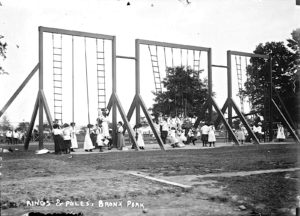“Vertical Climbing” was a major part of classical PE and fitness from the late 1800s into the early 1900s. This is a nice example of ropes and ladders. Let’s take a closer look.
From the far left, we see a rope ladder with fixed horizontal steps. There were many variations of climbing ladders which represented progressions (harder) and regressions (easier). These rope ladders would have been moderate as it’s easier to step on a flat and hard horizontal step; however, the bottom of the ladders do not appear to be tethered or tied into the ground making this a progression. Also, as common during this era, people worked in partners or small groups and spotted each other. The children holding the ladders at bottom would have been providing a regression, or if playing and shaking the ladder, it would have been a progression. These poles were “straight” all the way up, so that is a progression. Poles or ropes with ledges or knots would have been a regression making the climb easier for beginning levels.
Moving to the right, we see straight climbing poles. We know they are rigid because they are so straight. A fixed and straight pole would have been easier to climb, but once again, the pole is not tethered to the ground, so this provides an extra layer of difficulty or climbing challenge.
Moving to the center, we see gymnastic rings on the bottom of the center “poles.” These might have been ropes since rings are on them, but there is a young girl weighting down the verticals, so it’s hard to tell for sure.
Moving to the far right, we see the rope ladder quite twisted. There very well could have been different rope ladder levels on the same play area–this was quite common in order to accommodate different levels of difficulty and mastery. The rope ladders could have been untethered on this unit–not sure. The vertical climbing pole or ropes in center appear to be bent now, so they are likely ropes which would be a progression. Ropes were sometimes untethered, tethered, straight, or knotted. All of these adjusted the level of difficulty and were there for a reason.
Lastly, and THE most important part of the photo! Look carefully on the far right and you will see a rigid wooden ladder with far less height then the other climbing apparatus. This would have been the training area or most significant regression to the whole unit. This was definitely the “easiest” area on the whole unit and a place younger children could participate while observing and learning the more difficult moves from the older children.
The safety and quality of movement was quite significant during the era, so it’s common to see so many different levels of ability displayed in just one photograph.
It’s amazing what you can see and learn from history about movement if you know what to look for and how to interpret what you see. I hope this helps you.
Source: Bronx Park, NY, circa early 1900s
–Ron Jones, MS, Historical Kinesiologist, Physical Education/Health Science Teacher
ron@ronjones.org
661.993.7874
